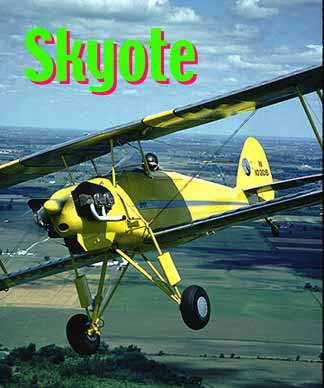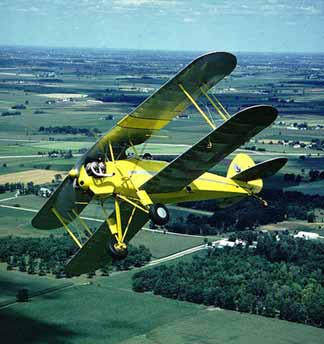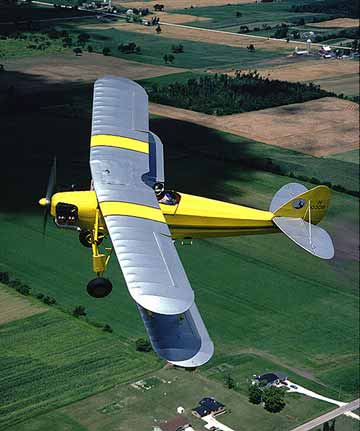

Air Progress, May, 1979
Story and photography by Budd Davisson
The best of the Jungmeister with the size of a Rose Parakeet and the looks
of a 1930s something or other.
Giggle . . . gigg , . . ! They kept bubbling up, like the fizz from champagne
that's been downed too quickly. Giggle! I couldn't stop them. Like hiccups,
little gasps of laughter kept bouncing against the back of my teeth, leaving
the taste of pure fun. Giggle! This was fun, Oh my God, was this ever fun! I
would sneak a peek to either side, half expecting to see somebody out there
watching me, at 3,000 feet, scratching their heads at my strange behavior. It
is after all just an airplane. But, it isn't. The Skyote is anything but "just
an airplane." The Skyote (pronounced Sky-oh-tee, as in coyote, or Sky-yoat,
as in coyote), is pure fun, an unbelievably free spirit wrapped in grade A and
butyrate that is what flying is supposed to be at its very, very best, The Skyote
is, or should be, a landmark airplane that I predict will become very, very
popular (Ed: wrong again, Budd. For whatever reason, few have been built.
What a shame!)
The Skyote is an environmentalist's approach to sport aerobatics and fun flying, Aero engineer Pete Bartoe, of Boulder, Colorado, decided to put together a performance package that had good manners at both ends of its speed envelope and would perform on low relatively inexpensive horsepower. This may not be an entirely new concept but it is certainly not one that has been seen recently. Most of the low horsepower biplanes available either can't get out of their own way or have the ground handling characteristics of a bongo board. Bartoe wanted something that would land like a Cub but do credible aerobatics, as well. Also, although he probably didn't use the word, he wanted it to look a little funky. And it does.
The secret to performance on low horsepower, if pure speed is ignored, is low
wing loading. The less weight you ask each square foot of wing to carry, the
fewer ponies you need to make it go. The only penalty you pay, in traditional
airframes anyway, is speed. However, that's not to say you're going to have
Volkswagens passing you. In the case of the Skyote, you get a happy little machine
that will bounce along all day at 100-110 mph and slurp only four or five gallons
of gas per hour,
The Skyote tips the scales at less than 600 pounds empty and grosses at about
900 pounds. With a C-90 Continental, that gives it a power loading of 10 pounds
per horse and a wing loading of only 7.2 pounds/square foot, which, if you aren't
into numbers, is pretty damned good. (Editors Note: speaking in new millenium
terms, don't ignore the fact that we have a wildly aerobatic airplane here that
qualifies for LSA rules, something we didn't think about back then but, is sure
as hell worth thinking about now.)
Light weight was the goal, and to achieve it, Bartoe used all
his engineering knowledge in designing the structure. This, according to some
of the builders, has resulted in a few things that might have been done simpler,
but would have added weight.
The fuselage is old-fashioned rag and tube, and Bartoe's computer whittled it
down everywhere he could, without sacrificing strength. The wing structure is
all aluminum, with the ribs being hydro-formed. All of the airframe loads are
transmitted directly through the centroids of the members involved, so no extra
weight is being carried around to make up for eccentric loading of fittings,
as is sometimes the case. Also, many of the airframe parts are right and left
oriented, rather than being interchangeable, which adds to the time required
in building.
Bartoe's plans are true engineering production drawings, and as such, may be
looked at as being too sophisticated for some. However, this is one set of drawings
that leaves nothing out, which is a good thing because they cost $275.
Part of the Bartoe Equation for excellent aerobatics and even better low speed
performance included sweeping both upper and lower wings. This gives the snap
rolls that little added push that only double swept wings can give. And, as
if the sweep isn't enough, he added four ailerons to boot. Of course, the lightweight
does wonders for the aerobatics, but does even more for the slow speed handling
and helps deliver a 38 knot (44 mph) stall.
It's hard to tell whether or not Bartoe engineered the giggle into the airplane,
or was just lucky, but he got it whether he wanted it or not. When I was walking
around Dwayne Burnett's Skyote at Oshkosh last year, I noticed that just about
everybody standing near the airplane was smiling, giggling or outright laughing
because the airplane was so darned cute. It seems to affect everybody the same.
Burnett and I worked out the details of checking me out in the airplane, which
included finding a decent piece of grass between the runway and the taxiway
at nearby Fon du Lac Airport. He took off and I followed in a Citabria loaned
to me for Oshkosh by Bellanca. Even as I shut down my camera plane and hopped
out, I looked at the Skyote, and smiled a little. Burnett, also of Boulder and
a friend who had a say in Bartoe's designing, walked me around the airplane,
explaining all the important things I ought to know. ". . . this is the
front and this is the back . . .'' He then ushered me to the flight deck and
stepped back to await my instructions for starting.
Actually, getting into the airplane is more complicated than flying it. The
sheet metal on both sides of the cockpit folds down Jungmeister style, exposing
a sizeable cavity. But, to get into it, the accepted method is to put one foot
in the step on the left side of the fuselage and swing your right foot clear
over the turtle deck, as if you were mounting a horse. Once you've got your
right foot inside, it's a simple matter of stuffing the rest of you right in
behind it.
The cockpit at first seems snug, but that's an illusion brought about because
there isn't much airplane around it. I'm a very average sized 5' 10" and
I had absolutely no areas that seemed tight. I'm certain that sixfooters would
have no problems. The real limiting factor isn't your height, but the width
of your shoulders. Since the sheet metal curves in fairly tightly to your neck
area, it might have to be slightly reconfigured to accept a guy with linebacker
shoulders.
There wasn't much else to do, once in the airplane, so, I yelled, "contact,"
Burnett yelled, ''okay," and a few seconds later I had 90 Continental ponies
galloping away just ahead of my toes.
The area I was flying from wasn't quite level; as a matter of fact it was one
side of a very shallow drainage ditch, so it sloped to one side. I figured this
might give me some trouble, so, as I taxied to the other end of the 1,500 or
so feet of "runway," I played with the rudders a bit and practiced
my "S" turns. Two things hit me immediately: First, the visibility
is so incredible (you can actually see over the nose, if you stretch), that
you don't need the S turns. Secondly, the tail follows your feet with little
or no argument. If you don't mess with the rudders, the tail stays directly
behind you and follows you straight ahead. Kick a little rudder and you get
just what you asked for, a little turn. Kick it a lot and you get a lot.
I swung around, watching the freshly-cut grass scatter in my prop blast, and
lined up ready to go. I gently started the tiny throttle moving forward and
heard the song of the C-90, exactly as I'd heard it a thousand times before,
as a student pilot in Champs. But this time, the song was dragging me down the
grass much faster than a Champ ever hoped to. The tail felt light almost immediately,
so I picked it up and was rewarded with a frighteningly clear view over the
nose. But, the view was short lived, because the airplane hopped into the air
and the grin, which had been suspended by a case of first-flight apprehension,
worked its way across my face, trying to connect my sideburns.

In most airplanes, there is an instant or two, sometimes stretching
into hours in real dogs, during which you find your senses searching to connect
with the machine so you can both occupy the same groove. In the Skyote, this
lasted just about as long as it took to reach the end of the runway. Maybe I
settled into the Skyote's groove so quickly because the second we cleared the
ground, I felt something I had known before and thought of often . . . the eerie,
smooth controls that, to my knowledge, exist only in the Bucker Jungmeister.
But, here they were again. My hand was for all practical purposes, connected
directly to the wing tips, because there was no detectible feeling of man-made
linkage that stood between me and flight, which was rushing past the windscreen.
The torque tubes and ball bearings, which made up the control system were doing
their job, making mine a very, very enjoyable one.
At 65-70 mph indicated and full throttle, I found the Skyote to be going up
faster than I had a right to expect. Although I didn't clock it from the deck,
at higher altitudes I timed it regularly between 1200 and 1500 feet per minute.
What was more obvious, however, was that because the rate of climb was so high
and the speed so low, the angle of our flight path formed with the ground was
much steeper than you usually see. This is the type of thing you get with light
wing loadings and reasonable power.
I suppose it gets boring to read how somebody else got their jollies by pulling
up into a four-point roll at every opportunity, but I can't help it. That's
what this airplane does for you. I didn't even bother leveling off . . . I just
pushed the nose over slightly to get 125 mph, pulled it back up and felt those
delicious ailerons flick me up and over. It is oh-so Bucker-like in so many
of its movements. It has that same subtle lightness that tells you your maneuvers
are graceful and tiny because the wings are alive and you are being lifted around
rather than being dragged around by a humungous motor.
Its snaprolls are very much like the Bucker's, only slightly slower. You can
almost ignore the technique you use—just a gentle yank-and-stomp procedure
works nicely. Bam! It breaks, whizzes around and squeaks to a halt the second
you smack the stick, asking it to stop.
 |
| With its double swept wings, the Skyote is born to snap |
The spins are also mucho fun, but happen faster than I had expected. With a
slightly forced entry, it snaps into an immediately stabilized spin and shows
no indication of wrapping up, at least not in the three-turn series I was doing.
It gives the impression of being fairly steep but stops in less than a half
turn once you initiate recovery.
The fuel gauge float was working its way toward the bottom when I chopped the
power and spiraled down toward the traffic pattern. Normally, I would have been
working on a first class case of nerves in anticipation of my first landing,
but somehow, I knew the little airplane was going to treat me just fine. So,
since I knew Dwayne and my friends were all sitting in the grass watching, I
concentrated on making this as pretty a landing as I could, which I don't do
very often.
It wasn't until I was on final and beginning to pin the air speed down to the
58 indicated that Dwayne had suggested that I realized that he was talking about
miles per hour and not knots. We were landing on the grass because we had a
fairly frisky little crosswind across the pavement, and when I got the speed
stabilized on 58 mph and worked the crosswind out, the airplane seemed as if
it was barely moving.
All of the good manners Bartoe had engineered into the airplane came out as
I began to flare and feel for the ground. That long out-rigger gear soaked up
any bumps and the airplane obediently rolled straight ahead for maybe 300-400
feet! It would have stopped on its own if I hadn't added a little power to taxi
up to where everybody else was standing.
To say that I personally like the Skyote, is putting it mildly. It combines
the best of the Jungmeister with the size of a Rose Parakeet and the looks of
a 1930s something or other. It does its entire number on 100 horses or less
(the C-85/C-90 series are preferable, but the 0-200/235 will work), and handles
like a feather. It makes a Citabria seem like a Pitts on rollout, by comparison
(Ed: I have since found that the narrow gear works you a little in crosswinds
on pavement.), and it makes a Pitts look like a Lunar Module when landings
are compared.
I can think of no other single place biplane that can do so much for the pilot
with so little It is a toy, to be sure, but in an age when gasoline burning
toys are becoming socially unacceptable, it stands almost alone in the acrobatic
or sport biplane field as being socially acceptable. Besides that, it's just
cute as hell.
For
lots more pilot reports like this one go to PILOT
REPORTS